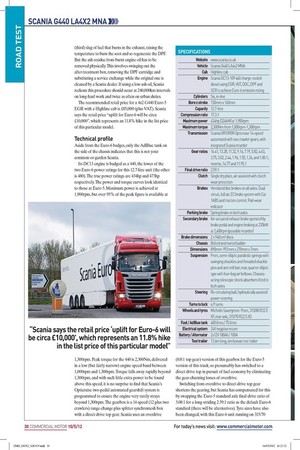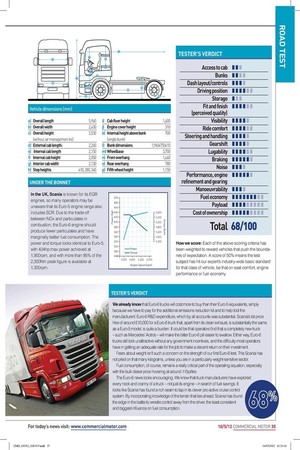SCANIA G440 LA4X2 MNA
Page 23

Page 24

Page 27

Page 28

If you've noticed an error in this article please click here to report it so we can fix it.
SPECIFICATIONS Website www.scania.co.uk Vehicle Scania G440 LA4x2 MNA Cab Highline cab Engine Scania DC13-109 440 charge-cooled diesel using EGR, VGT, DOC, DPF and SCR to achieve Euro-6 emission rating Cylinders Six, in-line Bore x stroke 130mm x 160mm Capacity 12.7-litre Compression ratio 17.3:1 Maximum power 434hp (324kW) at 1,900rpm Maximum torque 2,300Nm from 1,000rpm-1,300rpm Transmission Scania GRS905R Opticruise 14-speed automated with two crawler gears, with integrated Scania retarder Gear ratios 16.41, 13.28, 11.32, 9.16, 7.19, 5.82, 4.63,
3.75, 3.02, 2.44, 1.96, 1.55, 1.24, and 1.00:1; reverse, 14.77 and 11.95:1
Final drive ratio 2.59:1 Clutch Single dry plate, air-assisted with clutch wear protection Brakes Ventilated disc brakes on all axles. Dual circuit, full air, EC brake system with Cat 1ABS and traction control. Pad-wear indicator Parking brake Spring brake on both axles Secondary brake Air-actuated exhaust brake operated by brake pedal and engine braking at 235kW at 2,400rpm (possible retarder) Brake dimensions 2 x 940cm2 discs Chassis Bolted and riveted ladder Dimensions 890mm-951mm x 270mm x 7mm Suspension Front, semi-elliptic parabolic springs with swinging shackles and threaded shackle pins and anti-roll bar; rear, quarter elliptic type with four-bag air bellows. Chassisacting telescopic shock absorbers fitted to both axles Steering Re-circulating ball, hydraulically assisted power-steering Turns to lock 4.9 turns Wheels and tyres Michelin Savergreen. Front, 315/80 R22.5 XF; rear axle, 315/70 R22.5 XD Fuel / AdBlue tank 400 litres / 75 litres Electrical system 24V negative return Battery / Alternator 2x12V 180Ah / 100A Test trailer 13.6m long, 4m boxvan test trailer
CAB COMFORT
Highline is the largest of three cabs available in the G-range. From the ground to the cab floor height the cabs are identical, however, there are key height and weight differences thereafter. Highline is 200mm higher and approximately 90kg heavier than the Normal sleeper cab, and 400mm higher and approximately 160kg heavier than the Low sleeper cab.
There is the option for two bunks in both Highline and Normal cabs, but only one bunk in the Low cab. Internal cab height is 2,050mm from the footwell to the highest point in the ceiling over the engine cover.
This vehicle has two external lockers, three compartments above the windscreen, a drawer on top of the engine cover, and the optional fridge freezer located under the bunk. Additional storage includes door pockets and a single pocket above each door, twin-pockets on both sidewalls at each end of the bunk, and netting on the back wall. THE COMPETITION Mercedes-Benz Axor 1840L Fleet favourite, gaffer’s truck, liked by drivers, Axor can do no wrong. But time is ticking and when Euro-6 comes along, the Axor name will be consigned to history, replaced by Actros with smaller cabs and smaller engines. Volvo FM11/FM13 Quietly, Volvo Trucks, with its FM, has enjoyed notable success in the fleet sector. Like the Daf CF, it’s a choice that won’t see any transport manager fired. Volvo hasn’t revealed its plans for Euro-6 just yet but group cabs and engines with Renault Trucks will prevail.
CM’s road tests have changed, but you will find the same balanced and unbiased views as before, only in a new visual format, with more information to better reflect the modern purchasing decision. Each vehicle put through a CM road test is rated according to a strict set of parameters. We appreciate that certain factors are likely to hold more influence when it comes to buying a vehicle, which is why some criteria are scored more highly than others. For example, while we realise that safety is important, all vehicles are designed with high safety levels, so elements of the test that are more variable between vehicles, such as payload, are scored more highly than those where industry-wide standards are similar. This way our road tests reward vehicles that perform above expectation and penalise those that fall short. Our fuel economy test routes cover a variety of road types where normal economical driving techniques are employed and speed limits are rigidly observed. All additional testing is carried out at private test tracks using specialist equipment. Vehicle dimensions (mm UNDER THE BONNET In the UK, Scania is known for its EGR engines, so many operators may be unaware that its Euro-5 engine range also includes SCR. Due to the trade-off between NOx and particulates in combustion, the Euro-6 engine should produce fewer particulates and have marginally better fuel consumption. The power and torque looks identical to Euro-5, with 434hp max power achieved at 1,900rpm, and with more than 95% of the 2,300Nm peak figure is available at 1,300rpm. TESTER’S VERDICT We already know that Euro-6 trucks will cost more to buy than their Euro-5 equivalents, simply because we have to pay for the additional emissions reduction kit and to help foot the manufacturers’ Euro-6 R&D expenditure, which by all accounts was substantial. Scania’s list price hike of around £10,000 for a Euro-6 truck that, apart from its clean exhaust, is substantially the same as a Euro-5 model, is quite a burden. It could be that operators find that a completely new truck – such as Mercedes’ Actros – will make the bitter Euro-6 pill easier to swallow. Either way, Euro-6 trucks still look unattractive without any government incentives, and the difficulty most operators have in getting an adequate rate for the job to make a decent return on their investment.
Fears about weight isn’t such a concern on the strength of our first Euro-6 test. This Scania has not piled on that many kilograms, unless you are in a particularly weight-sensitive sector.
Fuel consumption, of course, remains a really critical part of the operating equation, especially with the bulk diesel price hovering at around 115p/litre.
The Euro-6 news looks encouraging. We know that truck manufacturers have explored every nook and cranny of a truck – not just its engine – in search of fuel savings. It looks like Scania has found a rich seam to tap in its clever pro-active cruise control system. By incorporating knowledge of the terrain that lies ahead, Scania has found the edge in the battle to wrestle control away from the driver, the least consistent and biggest influence on fuel consumption.












































